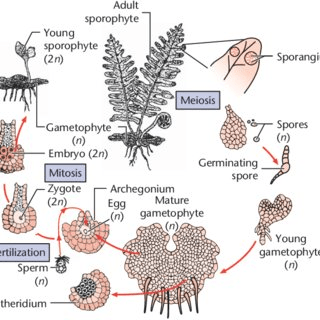This is the last group of non-flowering plants, the pteridophytes, included in this course. The most familiar plants of this group are ferns which we commonly see as houseplants, in parks and also in house landscapes along with other ornamental plants.
Ferns are rather small plants with graceful, often delicate compound leaves. Because of their beauty and difficulty in propagation, they are considered very precious plants.
In this article, you will study the general characteristics and life cycle of pteridophytes and the structure and morphology of some representative genera.
Scientists got the idea about the early vascular land plants from fossils – the extinct members. Rhynia and Cooksonia were the simple and most primitive pteridophytes. One of the simplest living members of this group is Psilotum.
You know, pteridophytes are vascular plants and they possess roots, stems, and leaves. All vascular plants possess water- and food-conducting pipelines made up of xylem and phloem tissues, respectively.
In different groups of plants, a great variation is found in the relative position and arrangement of the xylem and phloem, other associated tissues, and in the presence or absence of a pit. In pteridophytes, a natural gradation in vascular tissues from simple (primitive) to complex forms is observed.
Read Also: Environmental Factors Affecting Feed Consumption in Fishes
Pteridophytes Life Cycle

Have a good look at the pictures of a pteridophyte. What you see are sporophytes of these plants. Their gametophytes are very small only a few millimeters in size and are short-lived.
Let us first learn about the life cycle of pteridophytes because then it would be easier for us to list their characteristics. Like bryophytes, pteridophytes also have two distinct phases in the life cycle: gametophyte and sporophyte which follow each other in regular succession.
Since the two generations look different, they are termed heteromorphic. Under normal circumstances, gametophyte produces motile male gametes (sperms) and non-motile female gametes (eggs).
Fusion between an egg cell and male gamete results in the formation of a zygote which is diploid. The zygote divides by mitotic divisions and forms the sporophyte. On sporophyte a number of haploid, non-motile spores are produced by meiosis.
The life cycle is then completed when a spore germinates and produces haploid gametophytes by mitotic divisions.
You have studied that in bryophytes, the dominant phase in the life cycle is the gametophyte, and the sporophyte is either partially or completely dependent on it for nutrition. But in pteridophytes the sporophyte very soon becomes independent of the gametophyte and is the dominant generation.
The sporophyte shows a greater degree of complexity in the structural organization. It is organized into stem, root, and leaves, except in the most ancient fossil pteridophytes and in the most primitive living member. The vascular tissues (xylem and phloem) are developed only in the sporophytes.
Furthermore, the aerial parts are covered with a layer of cuticle. On the epidermis, there are stomata for the exchange of gases. These anatomical complexities of the sporophyte helped it inhabit a much wider range of environmental conditions than the gametophyte could.
Read Also: Morphology, Life Cycle, and Classification of Bryophytes
In summary, Pteridophytes, a fascinating group of plants that includes ferns and their allies, boast a life cycle characterized by alternation of generations. This intricate process unfolds in a manner that showcases the resilience and adaptability of these ancient green organisms.
The journey begins with the release of spores from the sporangia, which are tiny structures nestled on the underside of fern fronds. These microscopic spores, akin to nature’s seeds, are dispersed by the wind and other environmental factors.
Once settled in a suitable environment, the spore germinates, giving rise to a tiny, heart-shaped structure known as the gametophyte.
The gametophyte, often inconspicuous compared to its larger sporophyte counterpart, is a miniature yet crucial phase in the life cycle.
It is here that the plant undergoes a gendered division, producing male and female reproductive organs known as antheridia and archegonia, respectively. Water plays a pivotal role in this stage, aiding the motile sperm to swim to the egg for fertilization.
Upon successful fertilization, the zygote forms and develops into a new sporophyte. This marks the initiation of the dominant phase in the life cycle of pteridophytes—the fern that we commonly recognize.
The sporophyte matures into a complex structure with roots, stems, and leaves, showcasing the intricate patterns and shapes characteristic of ferns.
As the sporophyte matures, it produces specialized structures called sporangia on the undersides of its fronds. Within these sporangia, the next generation of spores is generated, completing the cycle and ensuring the continuity of the species. The sporangia burst open when mature, releasing the spores into the environment, restarting the life cycle.
This alternation between the gametophyte and sporophyte generations not only defines the life cycle of pteridophytes but also underscores their ability to adapt to diverse ecosystems.
From the microscopic beginnings of spores to the majestic ferns gracing forest floors, the life cycle of pteridophytes serves as a testament to the resilience and evolutionary brilliance of these captivating plants.





